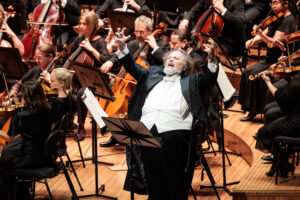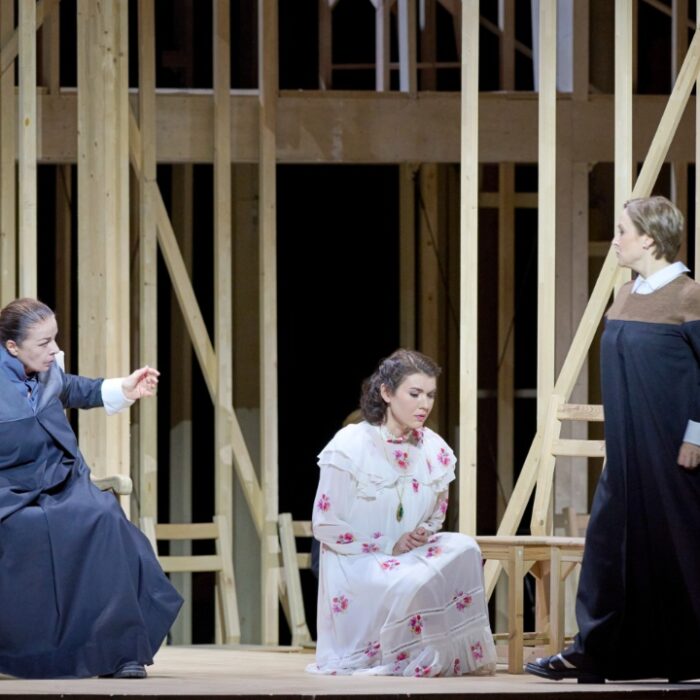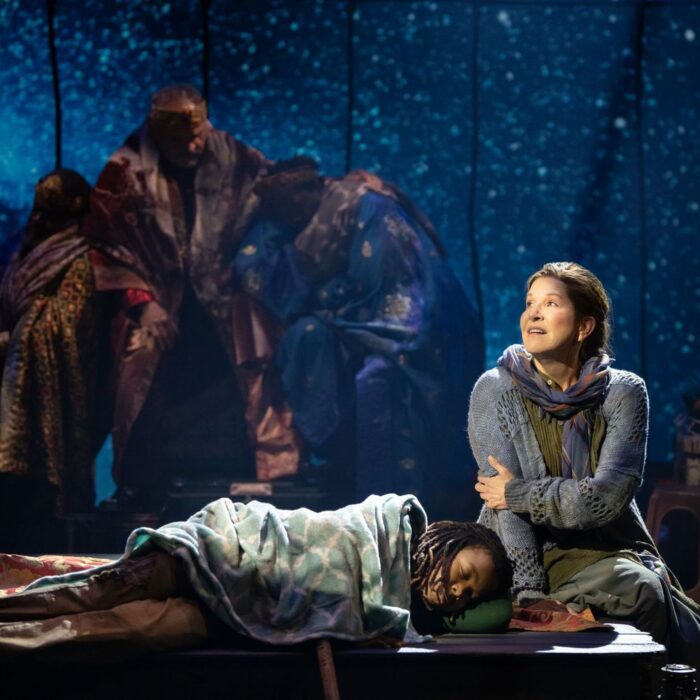
Sydney Symphony Orchestra 2025 Review: Siegfried
By Gordon Williams(Photo credit: Daniel Boud)
At the end of Act one of the Sydney Symphony’s “Siegfried,” on November 13th at the Sydney Opera House Concert Hall, one may have sensed from the onstage performers’ elation that Simon O’Neill as Siegfried, Gerhard Siegel as Mime, and conductor Simone Young knew they had nailed it. The audience’s applause was long and enthusiastic. A friend next to me whispered admiringly, “and this is only Act one!” Would the whole performance live up to that promise?
Performance Details
Act one of Wagner’s third Ring opera is, in many ways, quite severe. The Sydney Symphony’s pre-publicity noted “Siegfried” as being “packed with passion, violence, rage, betrayal and tragedy.” “Violence” and “rage” might be the key words. In the resolutely male world of Act one, Siegfried ultimately reforges his father’s splintered sword. But only after one sees the acrimonious relationship he has with the dwarf Mime, his surrogate parent, and the dark pronouncements of the god Wotan, now in the guise of a “way-weary” wanderer, soon to lose godly power.
Wagner intended Siegfried to emerge as the hero of his Nibelung epic. An audience-member can certainly empathize with the orphaned Siegfried’s yearning to know his true parentage, evident from Simon O’Neill’s poignant utterances of the word “Mutter.” Siegfried the character can come across as brutish and cruel, except for where the forest comes to the fore, such as in Act two where Siegfried ponders the identity of his mother, and the end of Act three when he discovers love initially likened to fear in the Siegfried-ian universe through Brünnhilde.
Simon O’Neill’s agile tenor voice conveyed a sympathetic brashness. His infectiously exciting “Forging Song” ending Act one was complete with foot-taps and other physical immersion in Wagner’s rhythmic energy. He radiated an appealing youthfulness right through to the end of the opera in what, it must be noted, is famously one of opera’s most taxing roles.
O’Neill has played Siegmund, father of Siegfried and hero of “Die Walküre,” several times. But O’Neill seemed to bring the greater warmth and romanticism of that heldentenor role to his interpretation of this central character. There was tenderness, particularly in Siegfried’s Act one description of his animal friends in the forest. How appropriate that the program booklet contained an essay by Peter Bassett on the opera’s transitioning of the Ring cycle from the world of the gods to “a focus on the power of nature–the world as we see and know it.”
“Violence, rage, betrayal and tragedy?” Yes, but in the emphasis on the natural world the printed program material offered an interesting further explanation of what the orchestra’s publicity meant when it went on to say that “Siegfried” is the Ring cycle’s “beating heart.”
In his appearances in Acts one and two, bass-baritone Wolfgang Koch as the Wanderer (Wotan) smoothly conveyed the serene stability that comes from godly power, albeit power that’s ebbing. There was poise and gravitas from him, although masking a still-terrible ability to dominate. The frightening sense of threat, for example, in the way Koch informed Siegel, as Mime, that he had reached the third and final riddle that may cost him his head. By Act three the Wanderer’s imminent defeat was palpable in Koch’s delivery of the famous line: “Do you know what Wotan wants?” Koch’s crescendo to the final word in the original German line, “Weisst du, was Wotan – will?,” observed an extra-long pause and could be thought to have expressed a final frustrated flaring-up of power before extinguishment. This was one of a few judiciously placed and seemingly longer-than-expected pauses with which conductor Young punctuated this score. More pauses took place after the Wanderer attempted one final challenge to Siegfried in Act three and Siegfried broke the Wanderer’s spear, a symbol of his authority. “Zieh’…hin!…Ich kann dich nicht halten!” [punctuation added] sang Koch effectively portraying a broken character.
More Stellar Cast Highlights
Arguably the revelation of the evening was Gerhard Siegel as Mime. From the moment Siegel jumped up at the beginning to sing “Zwangvolle Plage,” “Cursed compulsion,” he expressed his frustration at being unable to forge Siegfried a sword. It would not be an exaggeration to say that Siegel garnered sympathy for a character who is occasionally undermined through excessive caricaturing. I think not just of the genuine frustration of Siegel’s tears during “And I cannot forge it,” but the detail of pulling back when about to express too much tenderness toward Siegfried whom he plans to murder (“Mein Kind…”) In a work that is short of genuine duets, it was also truly thrilling when the two tenor voices of O’Neill and Siegel came together at the end of Act one’s Forging Song finale.
“Siegfried”s second Act includes the entrances of Mime’s brother Alberich, who started the Ring cycle’s downward spiral of destruction when he cursed the ring made from Rhine gold, and Fafner, the ring’s current custodian who, for the sake of possessing the ring, killed his brother Fasolt in “Das Rheingold” (the curse’s first casualty). Baritones Warwick Fyfe and Teddy Tahu Rhodes sang Alberich and Fafner respectively.
Fyfe sang Wotan in the production of the Ring in the Australian regional city of Bendigo in 2023 and when he stood next to Koch in this performance, as part of the modicum of blocking which elucidated relationships in this concert presentation, the audience could hear how aptly their voices complemented each other, underscoring Wagner’s description of Wotan as “Light-Alberich.” Alberich’s darker character might have been distinguished in such details as Fyfe’s bitter articulation of sibilants but when he rose to an outburst, “Through my curse, the guardians of the ring shall be slaves to death,” as transcribed from the excellent surtitles by Fiona Elizabeth Mizani/Librettitoli.com, an audience-member gained a graphic sense of just how closely Alberich’s power matched Wotan’s.
Teddy Tahu Rhodes was a commanding presence as Fafner, the giant transformed into a dragon guarding his horde of ring and Rhine gold. Through the simple device of a speaking tube, as specified by Wagner (“ein Sprachrohr”), Rhodes’ already-powerful presence was well amplified.
Reference was made earlier to the “resolutely male world” of “Siegfried.” Finally, this is leavened when the Woodbird enters. There was an almost heraldic quality to soprano Samantha Clarke’s pronouncements in this role. Her utterances spelled out, perhaps more than usually, how the color of the work was about to change.
The Orchestra’s Principal Cor Anglais, Alexandre Oguey, made the most of comic opportunity by overblowing and splitting notes, imitating Siegfried’s attempts to communicate with the Woodbird. In fact, the performance overall was successful in playing up the opportunities for comedy in this opera of “passion, violence, rage, betrayal and tragedy” that seems to derive from the more rough-and-tumble style of early low-comedy theater. In Act three, there was “the titter often aroused by Siegfried’s awestruck realization that the sleeping Brünnhilde ‘is no man,’” as Gordon Kerry writes in his excellent program notes. But several incidents elicited chuckles from the audience. In fact, all it took at one point was for Alberich and Mime to come on together. They were recognizable and laughed at as the comic villains.
Illuminating Music
In Act two, Guest Principal from the West Australian Symphony Orchestral David Evans played the highly exposed solo of Siegfried’s horn from up in the Concert Hall’s organ loft.
Act three gave us the remaining female voices as the opera points, again in Gordon Kerry’s words “towards a world beyond the forest where we meet Erda, and finally, in a radiant dawn, Brünnhilde.”
Contralto Noa Beinart, who performed as Erda in the Sydney Symphony’s “Das Rheingold” two years ago, when she and Wolfgang Koch enacted Wotan and Erda’s earlier confrontation, was a suitably eerie earth goddess with, once, a controlling knowledge of future events but now, disoriented by Wotan’s machinations to undo the curse, wanting to go back to her sleep.
Finally, though Brünnhilde is meant to be asleep on a rock where she ended up at the end of “Die Walküre,” Miina-Liisa Värelä stood where Beinart had stood, another of the fortunate ways in which the simple blocking of this production pointed out relationships and resonances, since Erda may have left the scene but it is Brünnhilde who will eventually emerge as the ‘hero’ of the cycle.
In the final moments of the opera, in which Brünnhilde humanizes Siegfried, Värelä, gave us a full panorama of emotion, from the covered tenderness of “Ewig war ich…” the music of Wagner’s later birthday gift to his wife, Cosima, to full-bodied affirmation of her love for the hero she waited for in her sleep.
Throughout the evening, conductor Young constantly revealed the beauties in Wagner’s music. Of course, the “Forest Murmurs” in Act two would be a prime candidate to point to, but there were genuinely beguiling pianissimos, e.g. at the beginnings of Acts one and two (tremolo-ing violas and cellos on the cusp of audibility). The huge rallying of horns in the Act three interlude after Siegfried has finally destroyed Wotan’s power ended in a quieter-than-expected ascension to top notes. Also, Siegfried’s diminuendo-ing horn in the organ loft in Act two. Was this what Wagner wanted? One might conclude from Heinrich Porge’s account of Wagner’s own rehearsals of this opera that Wagner was at pains to achieve every quiet dynamic he could.
In my notes I wrote of Young’s “intense management of the score” and this could be heard in some unique voicings (telling bass at the very end, for example) and the carefully-applied building up of colors in those two preludes, matched later and to breathtaking degree by the orchestral passage foreshadowing Brünnhilde’s awakening to the sun (and Siegfried’s kiss), “Heil dir, Sonne.” Young’s sharply-defined tempo contrasts also provided refreshing vigor, especially in those moments where Mime interjects against Siegfried’s more heroic utterances. The swiftness of the tempo on occasion in the love duet enabled the audience to be swept along by the lead characters’ ecstasy. In fact, among the visual pleasures of this production was seeing how Young swayingly shaped the fluidness of the score.
Possibly of the three Ring operas presented by the Sydney Symphony over the past three seasons, this presentation argued most strongly for seeing Wagner’s music drama as predominantly musical achievements, notwithstanding Wagner’s ideal of the “total work of art,” uniting poetry, drama, architecture, and stage movement.



